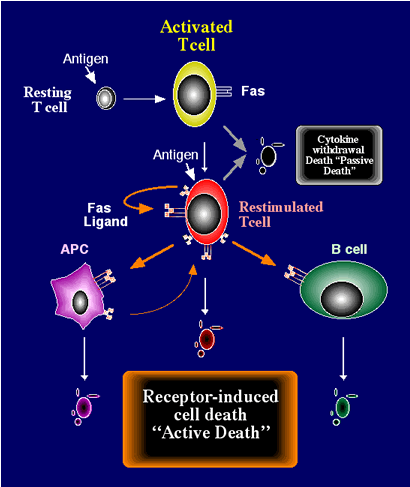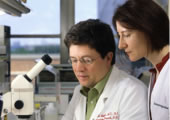You are here:
Related Information
Group Resources
Immunoregulation Section

Richard Siegel, M.D., Ph.D.
Chief, Immunoregulation Section
Autoimmunity Branch (AB)
Phone: (301) 496-5767
Fax: (301) 480-3880
E-mail: siegelr@mail.nih.gov
Research Overview
The goal of the Immunoregulation Group is to understand how alterations in regulatory signaling pathways in immune cells lead to abnormal immune responses, chronic inflammation, and autoimmune diseases. The TNF family of cytokines is the main focus of present work, as these cytokines are critical in the pathogenesis and treatment of a number of different autoimmune and inflammatory diseases. We are particularly interested in how membrane-proximal events in receptor signal transduction can be influenced by environmental or other signals to alter cellular responses, since understanding these principles may aid in designing more effective therapeutic strategies to modulate the effects of TNF-receptor family signaling in autoimmune and inflammatory diseases. The general strategy of the lab is to better understand basic mechanisms of transmembrane signal transduction by selected TNF family receptors using the both cell and molecular biology approaches. We are also interested in studying the role of particular TNF family ligand-receptor systems in immune cells through mouse models. Recently, the lab has focused on three members of the TNF-receptor superfamily
- Fas and Fas Ligand: The Fas receptor has been shown to be important in immunoreceptor-mediated apoptosis of activated T and B lymphocytes. Both humans and mice with germ line mutations in the death receptor Fas accumulate abnormal lymphocytes and develop systemic autoimmunity. While most patients with non-familial autoimmune disease do not carry germ line Fas mutations, there is evidence that Fas-mediated apoptosis may be impaired in the milieu of chronic inflammation. We have been investigating what signals regulate Fas-mediated apoptosis in T cells, with the eventual aim of harnessing these discoveries to modulate Fas-induced apoptosis for therapeutic goals in human disease. We have recently identified the Rac family of small GTPases as critical regulators of Fas-induced apoptosis. We are also studying the regulation of FasL trafficking and function and are studying the role of the Wiskott-Aldrich Syndrome Protein (WASp) in this process
- TNF Receptor 1 (TNFR1). This receptor is critical for triggering inflammatory responses in myeloid cells of the immune system and other organ systems, and has been successfully targeted by biologic therapeutics in rheumatoid arthritis and other inflammatory diseases. We are working with the Genetics and Genomics Branch in NIAMS to understand the pathophysiology of inflammation in patients with the TNF Receptor Associated Periodic Syndrome (TRAPS) a genetic autoinflammatory disease associated with dominant mutations in TNFR1. We have recently discovered that TNFR1 mutant molecules associated with TRAPS are misfolded and accumulate in the endoplasmic reticulum. We are characterizing the mechanisms by which these mutant receptors lead to hyperactivity of the innate immune system.
- DR3: The function of this TNF-family receptor, highly related to TNFR1 but expressed mainly on lymphocytes has not been well characterized. We are investigating novel contributions of this receptor and its ligand, TL1A, to the pathophysiology of autoimmune diseases.

Selected Publications
Meylan F, Richard AC, Siegel RM. TL1A and DR3, a TNF family ligand-receptor pair that promotes lymphocyte costimulation, mucosal hyperplasia, and autoimmune inflammation. Immunol Rev. 2011 Nov;244(1):188-96.
![]()
Ramaswamy M, Deng M, Siegel RM. Harnessing programmed cell death as a therapeutic strategy in rheumatic diseases. Nat Rev Rheumatol. 2011 Mar;7(3):152-60.
![]()
Bulua AC, Simon A, Maddipati R, Pelletier M, Park H, Kim KY, Sack MN, Kastner DL, Siegel RM. Mitochondrial reactive oxygen species promote production of proinflammatory cytokines and are elevated in TNFR1-associated periodic syndrome (TRAPS). J Exp Med. 2011 Mar 14;208(3):519-33.
![]()
Ramaswamy M, Cruz AC, Cleland SY, Deng M, Price S, Rao VK, Siegel RM. Specific elimination of effector memory CD4(+) T cells due to enhanced Fas signaling complex formation and association with lipid raft microdomains. Cell Death Differ 2011 Apr;18(4):712-20.
![]()
Meylan F, Song YJ, Fuss I, Villarreal S, Kahle E, Malm IJ, Acharya K, Ramos HL, Lo L, Mentink-Kane MM, Wynn TA, Migone TS, Strober W, Siegel RM. The TNF-family cytokine TL1A drives IL-13-dependent small intestinal inflammation. Mucosal Immunology 2011 Mar;4(2):172-85.
![]()
Simon A, Park H, Maddipati R, Lobito AA, Bulua AC, Jackson AJ, Chae JJ, Ettinger R, de Koning HD, Cruz AC, Kastner DL, Komarow H, Siegel RM. Concerted action of wild-type and mutant TNF receptors enhances inflammation in TNF receptor 1-associated periodic fever syndrome. Proc Natl Acad Sci U S A. 2010 May 10. [Epub ahead of print] PubMed PMID: 20457915.
![]()
Steward-Tharp SM, Song YJ, Siegel RM, O'Shea JJ. New insights into T cell biology and T cell-directed
therapy for autoimmunity, inflammation, and immunosuppression. Ann. N.Y. Acad. Sci. 2010 Jan;1183:123-48.
![]()
Ramaswamy M, Cleland SY, Cruz AC, Siegel RM. Many checkpoints on the road to cell death: regulation of Fas-FasL interactions and Fas signaling in peripheral immune responses. Results Probl Cell Differ. 2009;49:17-47.
![]()
Goyal R, Bulua AC, Nikolov NP, Schwartzberg PL, Siegel RM. Rheumatologic and Autoimmune Manifestations of Primary Immunodeficiency Disorders. Current Opinion in Rheumatology, 2009 Jan;21(1):78-84.
![]()
Meylan F, Davidson TS, Kahle E, Kinder M, Acharya K, Jankovic D, Bundoc V, Hodges M, Shevach EM, Keane-Myers A, Wang EC, Siegel RM. The TNF-family receptor DR3 is essential for diverse T cell-mediated inflammatory diseases. Immunity. 2008 Jul;29(1):79-89. Epub 2008 Jun 19.
![]()
Reviewed September 24, 2012




